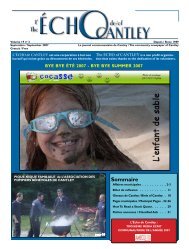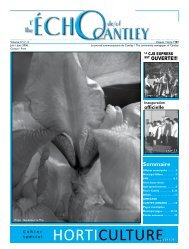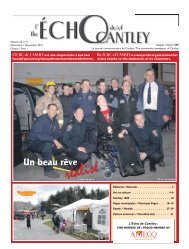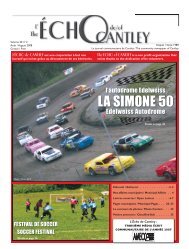La nouvelle école primaire de Cantley, la construction est commencée
La nouvelle école primaire de Cantley, la construction est commencée
La nouvelle école primaire de Cantley, la construction est commencée
Create successful ePaper yourself
Turn your PDF publications into a flip-book with our unique Google optimized e-Paper software.
O BSERVATIONSLes Oiseaux <strong>de</strong> <strong>Cantley</strong> — Birds of <strong>Cantley</strong>Le mois <strong>de</strong>rnier,nousavons re<strong>la</strong>té <strong>la</strong> suite <strong>de</strong>l’histoire du couple<strong>de</strong> Tyrans huppésqui nichaient chezCéline et Pierresur <strong>la</strong> rue Rémi.Ils s’étaient dépêchés<strong>de</strong> construire un nichoir en voyantles tyrans chercher à s’installer dansleur cour. Le couple a aussitôt adoptéle joli nichoir proposé et le 20 juinnaissaient <strong>de</strong>s oisillons. Le 1 er juillet,les oisillons quittaient le nid. Le nichoirmaintenant vi<strong>de</strong>, Pierre et Richardsont récemment allés l’ouvrir et y ontdécouvert trois oisillons morts au nid.Cette espèce <strong>de</strong> tyran pond en moyenne<strong>de</strong> quatre à huit œufs. On peut doncsupposer qu’au moins un oisillon asurvécu. Il <strong>est</strong> très difficile <strong>de</strong> savoir,vu que les oisillons ne s’attar<strong>de</strong>nt pasautour du nid bien longtemps.Les Roselins pourprés sont <strong>de</strong>retour sur <strong>la</strong> rue Rémi. Diane etRichard les voient et nous <strong>de</strong> même.Pendant que certains d’entre nous seba<strong>la</strong>daient au Bluesf<strong>est</strong>, d’autres chanceuxont pu entendre le merveilleuxchant <strong>de</strong> <strong>la</strong> grive <strong>de</strong>s bois. Son chantflûté et mélodieux <strong>est</strong> <strong>de</strong> loin un <strong>de</strong>splus beaux chants parmi les espèces<strong>de</strong> grives. Tous les observateurs <strong>de</strong> <strong>la</strong>rue préten<strong>de</strong>nt avoir vu <strong>de</strong>s Cardinauxrouges, mais Richard et Diane voientaussi le Cardinal à poitrine rosée. Enplus, les nombreux Quiscales bronzésdans leur cour vi<strong>de</strong>nt leurs mangeoiresen un rien <strong>de</strong> temps. Ces temps-ci,alors que les petits fruits mûrissent, onpeut voir les Jaseurs d’Amérique sedép<strong>la</strong>cer en groupe d’un arbre fruitier àun autre et gober les petits fruits d’untrait. Ils affectionnent particulièrementnos viornes pimbina. Quant à Richard,il doute être en mesure <strong>de</strong> se leverassez tôt pour manger au moins un <strong>de</strong>ses bleuets!Les oiseaux <strong>de</strong> proie sont aussi trèsactifs en cette pério<strong>de</strong>. Dans le secteur àl’angle du chemin Taché et <strong>de</strong> l’avenueGatineau, Diane et Richard ont aperçuun Faucon émerillon, le <strong>de</strong>uxième pluspetit faucon, un Épervier <strong>de</strong> Cooper etune Petite buse.Tous les matins où Dominic doitmener ses enfants à <strong>la</strong> gar<strong>de</strong>rie, ilentend piailler et gazouiller <strong>de</strong>s Bruantsà gorge b<strong>la</strong>nche.L’été <strong>est</strong> <strong>la</strong> saison durant <strong>la</strong>quellele Club <strong>de</strong>s ornithologues fait relâche.Malgré tout, une activité <strong>de</strong>meureintéressante. Comme il a été annoncé lemois <strong>de</strong>rnier, tous les mercredis d’août,le club organise une sortie pour observeret dénombrer les Gran<strong>de</strong>s aigrettesalors qu’elles rentrent au dortoir <strong>de</strong>l’île Conroy, aux rapi<strong>de</strong>s Deschênes.Pour plus <strong>de</strong> détails sur les activités duclub, consultez le site Internet du COOà l’adresse suivante : www.coo.ncf.ca.Wes Darou & Louise <strong>La</strong>perrièreAu cours du prochain mois, surveillezles juvéniles ou encore les adultesqui couvent une <strong>de</strong>uxième nichée. Il <strong>est</strong>aussi intéressant <strong>de</strong> surveiller <strong>la</strong> chaînealimentaire, par exemple, un insecte quigobe un autre insecte, puis se fait luimêmeprendre par un oiseau, qui à sontour le donnera à son oisillon affamé!Pour nous faire part <strong>de</strong> vos observations,veuillez communiquer avec nouspar courriel à oiseaux@echocantley.ca ou en composant le 819 827-3076.Prenez soin <strong>de</strong> bien noter <strong>la</strong> date,l’heure et l’endroit où l’oiseau a étéobservé, <strong>de</strong> même que ses caractéristiquesparticulières. Une photo ai<strong>de</strong>toujours à l’i<strong>de</strong>ntification.As a remin<strong>de</strong>r, <strong>la</strong>st month we talkedabout how Céline and Pierrebuilt a birdhouse in a f<strong>la</strong>sh when theysaw a n<strong>est</strong>ing pair of Great Cr<strong>est</strong>edFlycatchers staking out their yard. Thebirds accepted the new house almostimmediately. Well, it seems to haveworked. They n<strong>est</strong>ed and <strong>la</strong>id eggs,and the chicks hatched. Pierre andRichard found three <strong>de</strong>ad chicks in thebirdhouse. But this Flycatcher producesfour to eight eggs, so presumably atleast one survived. It is hard to prove.The chicks don’t stick around for long.The chicks hatched on June 20th andthen flew the coop on July 1 st .The Purple Finches have comeback to Rémi Street. Diane and Richardhave seen them and so have we. Someof us went to Bluesf<strong>est</strong>, meanwhileothers were enchanted by the song ofa Wood Thrush in our back yards. It isone of the most beautiful calls, but itdoes sound like it is from another p<strong>la</strong>net.We all have Cardinals, but Richardand Diane also have the Rose-breastedtype. There are enough Grackles aroundthat they can empty fee<strong>de</strong>rs. The CedarWaxwings have also begun to feed ona circuit of various fruit bearing trees inthe area. They really like our high bushcranberries, but we p<strong>la</strong>nted them justfor the birds. Richard, however, doesn’tthink he’ll be up early enough to savehis blueberries.This is an active time for birdsof prey. In the area around Taché andGatineau Ave., Diane and Richard haveseen a Merlin (our second small<strong>est</strong>Falcon), Cooper’s Hawk and a BroadwingedHawk.Dominic reports that he listens tothe White-throated Sparrows goingcrazy every morning as he takes hiskids to day-care!Summer is the slow period forthe Club <strong>de</strong>s Ornithologues. The onlyactivity however is kind of fun. EveryWednesday in August, there will be,for the third consecutive year, outingsto observe and count Great Egrets intheir night roosts on Conroy Is<strong>la</strong>nd atthe Deschênes Rapids. Check the COOweb site at www.coo.ncf.ca for <strong>de</strong>tails.This time of year, watch for theend of the fledging period or for adultsraising a second brood. It is also inter<strong>est</strong>ingto watch the feeding chain frominsect to insect to bird to bird!To report an observation, send amessage to our email address birds@echocantley.ca or call us at 819 827-3076. Note the date, time, location andparticu<strong>la</strong>r characteristics. Photos arealways welcome.Photo : Tyran huppé avec libellule au bec pour son petit, Pierre <strong>La</strong>ndry / Great-Cr<strong>est</strong>ed Flycatcherwith dragonfly for young, Pierre <strong>La</strong>ndry, 2013-06-29Photo : Libellule lydienne ou le repas du Tyran huppé.Common Skimmer or Flycatcher’s lunch, Pierre <strong>La</strong>ndry, 2013-07-1734 The ECHO of CANTLEY, August 2013
















